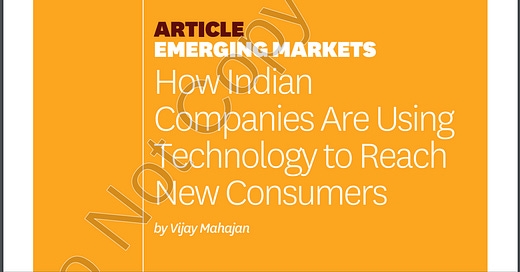I think there’s no need for India to go through learning curves as developed markets did, eg. in putting down plenty of copper in the ground for their telecommunication systems, and watching its value depreciate rapidly when cellular became popular.
I am particularly impressed by UPI, which has made cash transfer instant and painless. This in effect has meant India doesn’t have to go through either the cheque phase or the credit card phase and leapfrogged directly to mobile-based money transfer. This works well for individuals too: yesterday I had to share the cost of cutting a tree with my neighbor, and he sent me his share by Google Pay instantly.
Almost every shop I patronize prominently displays UPI/Google Play signs. Yesterday, I paid the modest-sized grocery store, small drugstore, tiny vegetable shop, and the fish delivery man, all with UPI transfers. The only person I had to pay in cash was the man who came to pluck coconuts. I didn’t ask him, maybe he’ll take UPI payments on his mobile too. I will ask him when he comes next in a couple of months.
Instead of being a proprietary walled-garden superapp, UPI is an open platform. I used to use BHIM, the government’s own app, all the time. I think it’s probably the most secure, but it’s a little cumbersome, so I now divide my payments between it (utilities and larger payments) and Google Pay (everyday expenses under Rs. 2000).
I totally bypassed the ‘wallet’ phase as well. I never used one, because I feared my financial data would go to Chinese servers. It may still go out of country (unless GDPR type legislation forces Google Pay, Amazon etc. to keep Indian data here), and possibly because I have a Xiaomi phone, and god knows what information it sends out; and oh, CIBIL is owned by TransUnion, an American firm.
On the supply-chain side, there’s the example of Rivigo, which seems to have revolutionized trucking in India by the simple expedient of making it a sort of truck-relay rather than having a single driver take the truck all the way from origin to destination.
It has slashed costs, partly also thanks to the GST which reduced or eliminated all those long wait-times at state border check-posts, not to mention substantial bribes every step of the way.

An Indian-American professor wrote an interesting article in a recent Harvard Business Review issue, and once you get over his somewhat supercilious tone he has a few good points. Indian firms are indeed using tech to reach out.
My students do a project every year to find innovative early-stage companies in India. I have been pleasantly surprised at the number of good ideas they discovered: everything from AI applied to medical imaging (qure.ai) to a supply chain for fresh fish and meat (Fresh to Home) to connecting farmers to consumers directly. All of these are imaginative uses of technology to solve problems that may be local, but could scale to much of the rest of the world.
There are also interesting companies elsewhere using technology cleverly. I was impressed by The Not Company from Chile that uses AI/ML called ‘Guiseppe’ to figure out how to make vegan food analogs to standard products: I have personally tasted their Not-Mayonnaise that is purely a plant product, and it is hard to tell from the original. They have Not-Milk, too.
I think there will be immense benefits from things like blockchain. A few years ago, I came across a company in Ghana using blockchain to maintain land records. Then there was a startup that was using discarded cellphones as monitors to record the sounds of chainsaws doing illegal logging in tropical rainforests.
Technology can be helpful for many at the Bottom of the Pyramid. The cellphone is a particularly good example. Today every maid, casual laborer, coconut plucker, vegetable vendor, trash collector, itinerant ironing person, etc. has a cellphone, and that makes them far more efficient: they can schedule their lives better, and can have access to more customers of their products or services.
Another slightly old example is that of disintermediation on the Kerala coast. Fishermen going out to sea found out that the signals were available a few kilometers off the coast, and started using them for storm warnings and such. Then they found out that they could decide which fishing port to land at, where they could get the best prices for their catch.
They also found out that they didn’t need the usual middlemen, and they could sell directly to bulk buyers. An academic paper found out that this saved roughly 12% of the cost; the fishermen kept 8% and the buyer got the rest.
Despite the many vices (eg. watching trash video or playing games, harassing and stalking people) that cell phone usage encourages, the technology has definite upsides. This is true of many other technologies, and as they trickle out, people find novel, unimagined, and wholly remarkable ways of using them.


